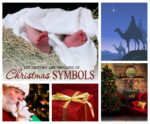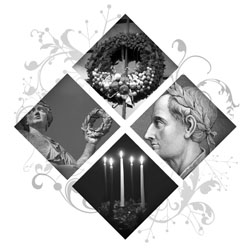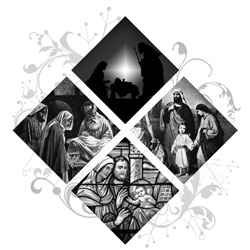Mistletoe
The following text is drawn from our featured Christmas book and is also available for free as audio.
 There are a great variety of species of mistletoe; most of them are evergreen and bear their fruit (generally either red or white berries) in the early winter. Since so few plants remain green in the winter, mistletoe naturally came to be associated with the Christmas season.
There are a great variety of species of mistletoe; most of them are evergreen and bear their fruit (generally either red or white berries) in the early winter. Since so few plants remain green in the winter, mistletoe naturally came to be associated with the Christmas season.
The botanical name for the genus of mistletoe is Phoradendron (phor meaning “thief” and dendron meaning “tree” in Greek). As a partly parasitic plant, mistletoe does in fact act like a thief, because it “steals” nutrients from its host tree. But it is only “partly” parasitic, because it has the ability to photosynthesize its own food and survive independently. However, mistletoe is generally found on trees, and it will use whatever means necessary to survive. It has been known to endure extremely harsh weather and even droughts by reaching deep beneath the tree bark of its host to drain water and minerals.
Likely, due to its tenacity to survive, mistletoe came to play a prominent role in many pre-Christian traditions: Druidism, Nordic legend and Greco-Roman mythology.
The Druids believed that mistletoe would make barren animals fertile and would act as a remedy against any kind of poison. Some scholars believe that the practice of kissing under mistletoe originated with the Druid notion that mistletoe helped to “bring forth” life through the union of male and female.
In Norse mythology, mistletoe played a significant role in the story of Balder, the god of light. After Balder became troubled by dreams that he would die, his mother extracted an oath from all the creatures and things on earth not to harm her son. Unfortunately, she overlooked one thing, mistletoe, because she thought it was harmless. Learning of this oversight, a mischievous and jealous god named Loki persuaded another one of the gods to hurl mistletoe at Balder, who died of the wound. The beloved Balder’s death was mourned throughout the world.
This story inspired a curious practice among the Nordic people in which mistletoe would become a symbol of protecting life. Basically, when enemies met under mistletoe, they were obligated to drop their weapons and embrace. Perhaps in honor of Balder, the Nordic people would hesitate to needlessly harm one another. Surely, Balder’s death was pointless and resulted only in sorrow. An embrace would further emphasize the commitment of good will between enemies in the presence of mistletoe. This ancient tradition may be another source for the modern custom of kissing when men and women (sworn enemies throughout history) meet under mistletoe.
The plant also plays a part in Greco-Roman Mythology. In the epic poem Aeneid, the hero Aeneas desires to seek counsel from his deceased father in the land of the dead. A prophetess advises Aeneas that he must seek a “golden bough (branch)” in order to return safely from the land of the dead.
Most scholars believe that the “golden bough” is mistletoe on the branch of a tree, since mistletoe can have a golden-like appearance. Interestingly, since the Middle Ages, Virgil’s writing (the author of Aeneid) has come to be viewed as symbolic and even prophetic regarding many aspects of Christianity. Whether there is any merit to this claim or not, the image of a golden branch certainly calls to mind the many Old Testament references to Messiah as the “Branch.” Since the purpose of Virgil’s golden branch was to save Aeneas from the land of the dead, the reflection of Jesus is further emphasized in the Christian mind.
Interestingly, many of the pre-Christian traditions surrounding mistletoe and its power to protect survived well into the Christian era. Mistletoe was hung over doors as protection from witches and demons, hung in cradles to protect infants from fairies and kept in homes as protection from fires. Surely, mistletoe has no power to offer such protection, but let it serve as a reminder of the One who truly can protect our lives and, more importantly, our souls – Jesus Christ, the One who Isaiah called the “beautiful and glorious Branch of the Lord!”
Back to Main Christmas Symbols Page.
We welcome your questions and feedback. If you are seeking information on mistletoe that is not found on our website, please contact us.
This content has a copyright © 2008 by Angie Mosteller. Please cite the source if you use this material: http://www.celebratingholidays.com/?page_id=1572.






